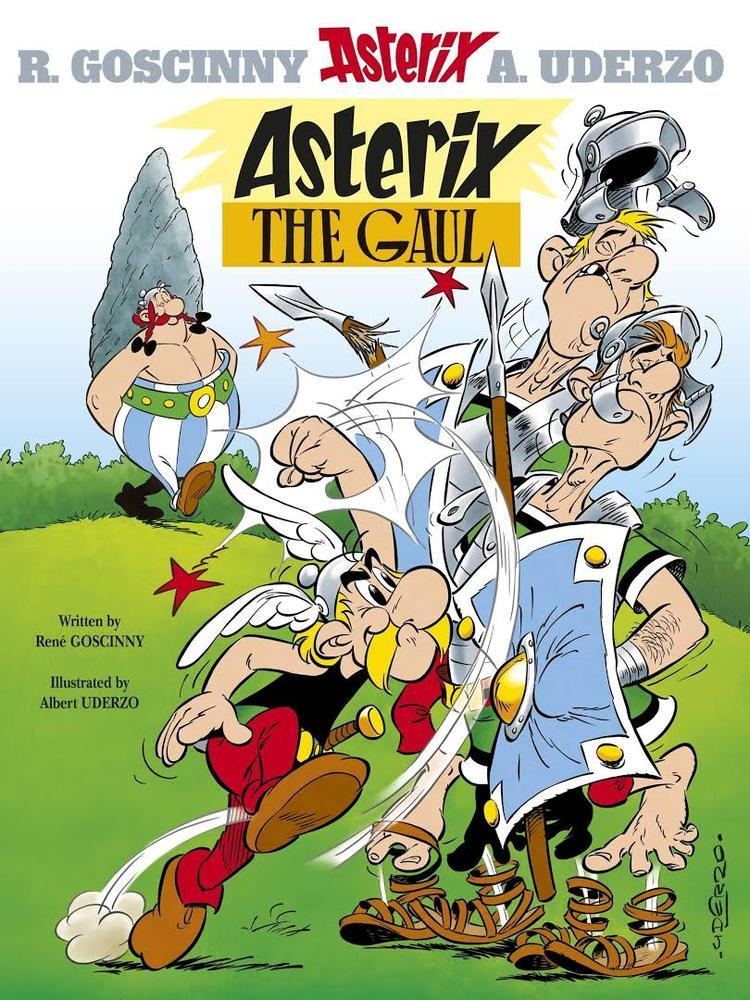8.4 /10 1 Votes8.4
Date 1961 Issues 1–38 | 4.2/5 Goodreads Originally published 29 October 1959 | |||||||||||||||||||||||||||||||||
 | ||||||||||||||||||||||||||||||||||
Date of publication 29 October 1959–14 July 1960 Similar René Goscinny books, Asterix books, Other books | ||||||||||||||||||||||||||||||||||
Asterix the gaul 1967
Asterix the Gaul is the first volume of the Asterix comic strip series, by René Goscinny (stories) and Albert Uderzo (illustrations). In Le Monde's 100 Books of the Century, a 1999 poll conducted by the French retailer Fnac and the Paris newspaper Le Monde, Asterix the Gaul was listed as the 23rd greatest book of the 20th century.
Contents
- Asterix the gaul 1967
- Asterix the gaul movie part 2
- Plot summary
- Introducing
- Development
- Publishing history
- British comic adaption
- Film adaptation
- In other languages
- References
Asterix the gaul movie part 2
Plot summary
All Gaul is under Roman control, except for one small village in Armorica (present-day Brittany), whose inhabitants are made invincible by a magic potion created periodically by the Druid Getafix. To discover the secret of the Gauls' strength, Centurion Crismus Bonus, commander of a Roman garrison at the fortified camp of Compendium, sends a spy disguised as a Gaul into the village. The Roman's identity is revealed when he loses his false moustache, shortly after he discovers the existence of the magic potion; whereupon he reports his discovery to the Centurion.
Crismus Bonus, hoping to overthrow Julius Caesar, orders Getafix captured and interrogated for the recipe; but to no avail. Protagonist Asterix learns of Getafix's capture from a cart-seller; infiltrates the Roman camp in the latter's cart; and hears Crismus Bonus revealing his intended rebellion to Marcus Ginandtonicus, his second-in-command. Following Asterix's suggestion, Getafix pretends to agree to the Centurion's demand of the potion when Asterix pretends to give in to torture, and demands an unseasonal ingredient: strawberries. While Crismus Bonus' soldiers try to find strawberries, Asterix and Getafix relax in relative luxury; and when the strawberries arrive, consume them all, and console Crismus Bonus that the potion may be made without them.
After all the ingredients are found, a potion is prepared that causes the hair and beard of the drinker to grow at an accelerated pace. The Romans are tricked into drinking this potion and before long, all of them have long hair and beards. When Crismus Bonus pleads Getafix to make an antidote, the druid makes a cauldron of vegetable soup (knowing that the hair-growth potion shall soon cease to take effect), and also prepares a small quantity of the real magic potion for Asterix. As Getafix and Asterix escape, they are stopped by a huge army of Roman reinforcements commanded by Julius Caesar. Upon meeting Asterix and Getafix, Caesar hears of Crismus Bonus' intentions against himself; deports Crismus Bonus and his garrison to Outer Mongolia; and frees Asterix and Getafix for giving him the information, while reminding them that they are still enemies. The two Gauls then return to their village, where their neighbors celebrate their recovery.
Introducing
Development
Because this is the first album, many story points and characterisations are still in their formative stages. In fact, due to its original, serial nature, some develop and change even as the story progresses:
Publishing history
The story was first published as a serial in Pilote magazine, a Franco-Belgian comics magazine founded by Goscinny and a few other comic artists.
The first page appeared in the promotional issue #0, distributed on June 1, 1959, and the story was serially published in the magazine from issue #1 (October 29, 1959) until issue #38 (July 14, 1960). A small head of Asterix first appeared on the cover of #9 (December 24, 1959), and a full Asterix cover was used on #21 (March 17, 1960).
The next story, Asterix and the Golden Sickle, started in issue #42 (August 11, 1960).
Asterix le Gaulois was published in July 1961 by Dargaud in the so-called "Pilote collection" with a print of 6000 copies. A Dutch translation followed in 1966, and other languages followed soon after.
The English translation by Anthea Bell and Derek Hockridge was first published in 1969 by Brockhampton Press.
The plate for page 35 was redrawn by Albert Uderzo's brother Marcel in 1970 because the original was lost. This is why there are some slight differences in the drawing style. All English versions from Hodder & Stoughton (Hodder Dargaud) use the original illustrations, which were made from a copy of an actual printed page, hence the blurriness. The 2004 release from Orion Books uses the redone illustrations from the French editions.
An audiobook of Asterix the Gaul adapted by Anthea Bell and narrated by Willie Rushton was released on EMI Records Listen for Pleasure label in 1990.
On the 29th of October, 2009, Google prominently featured an integration of Asterix and Obelix in its mast head, celebrating the 50th anniversary of the first publication.
British comic adaption
Valiant comics saved #59 (16th Nov 1963) carried a British version of Asterix with just the names changed which ran for a time, on the back page (so it was in colour). It was called "Little Fred and Big Ed" and they lived in a British village called Nevergiveup, the druid was named Hokus Pokus and the chief Roman was called Pompus.
Film adaptation
The book was adapted into a film, which was released in 1967. Goscinny and Uderzo were not consulted during the making of the film, and the first they heard of it was a few months before it was released, when they were shown an early version of it. It was generally not well received, and a planned adaptation of Asterix and the Golden Sickle, made by the same animation team, was scrapped.
